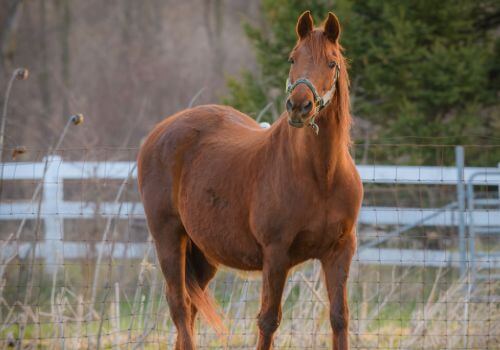The Morgan: America’s First Breed!
- Weight: 900 to 1,000 pounds
- Height: 14 hands (56 inches) to 15 hands (60 inches)
- Body Type: Compact, muscular build; short head with wide forehead; large, expressive eyes; high head and tail carriage; thick mane and tail
- Best For: Owners and riders of all levels, including children
- Life Expectancy: 30 years
The Story Behind the Morgan Horse
The Morgan horse is one of the first horse breeds developed in the United States, originating from a stallion named Figure, owned by Vermont schoolteacher Justin Morgan in the late 1700s. Figure was known for his athleticism, pleasant disposition, and ability to out-pull and out-distance other horses. His offspring inherited these traits, leading to the development of the Morgan breed.
Over time, the breed became an all-purpose horse, excelling in harness, under saddle, on the racetrack, and in farm work. Since their original breeding, Morgans have contributed to the bloodlines of several other breeds, including the American Quarter Horse and the Standardbred. The American Morgan Horse Association was established in 1909 to preserve and promote the breed and offers resources for Morgan Horse owners.

What’s Special About a Morgan Horse?
Morgans are known for their friendly and cooperative temperament, often described as "the horse that chooses you." They are intelligent, eager to please, and highly adaptable, making them suitable for riders of all levels. Their athleticism and behavior allow them to excel in various disciplines, including dressage, driving, therapeutic riding, and even police work.
How Big Is a Morgan Horse?
Morgan horses are slightly smaller than many other full-sized horse breeds, standing between 14 and 15 hands tall and weighing between 900 and 1,000 pounds. Despite their smaller stature, they are known for their strength and endurance. Their compact build, strong legs, and arched neck contribute to their elegant and refined appearance.
The Many Colors of Morgan Horses
Morgans come in a variety of colors, though they are most commonly seen in bay, black, and chestnut. Some breeders produce Morgans with palomino, pinto, gray, dun, and roan coats. There is no official breed standard for coat color, allowing for a diverse range of appearances within the breed.
What are Morgans Used For?
The Morgan horse's versatility has made it a favorite for various equestrian disciplines. Historically, they were used for farm work, racing, and cavalry mounts. Today, Morgans can be found in dressage, jumping, driving, pleasure riding, and therapeutic riding programs. Their bravery and steadiness also make them excellent choices for mounted police units.
Diet and Nutrition of Morgans
Morgans are considered "easy keepers," meaning they require less food to maintain their weight than other full-sized horse breeds. Their diet consists of high-quality grass, hay, and grains, with careful portion control to prevent obesity. Overfeeding, especially sweet foods, should be avoided to maintain a healthy body condition. A well-balanced diet discussed with your veterinarian is important.

Common Health Issues of Morgan Horses
- Polysaccharide Storage Myopathy (PSSM): A muscle disorder that can cause stiffness and pain, requiring dietary management with a low-starch, high-fat diet.
- Obesity: Morgans are prone to weight gain if overfed, so careful monitoring of their diet is essential.
Grooming and Care of Your Morgan Horse
Morgan horses require regular grooming to maintain their thick mane and tail. Brushing should be done at least once or twice a week to remove dirt and tangles. Special attention should be given to their hooves, which should be cleaned daily to prevent infections and injuries.
Saddling Up Our Final Thoughts
The Morgan horse is a beloved breed known for its friendly personality, adaptability, and strength. Whether used for work, sport, or companionship, the Morgan continues to be a versatile and cherished horse for equestrians of all levels.
